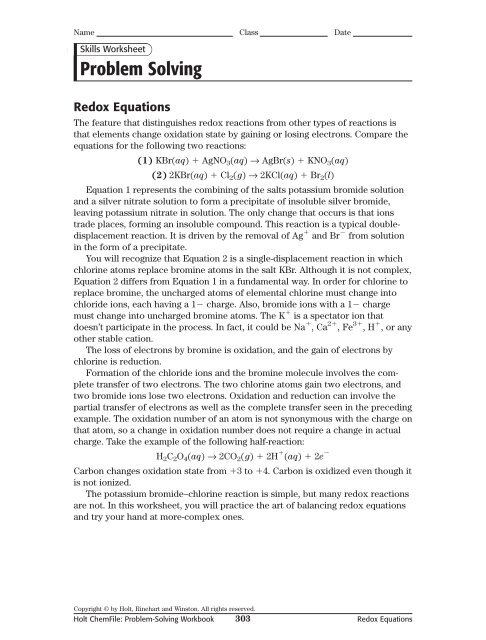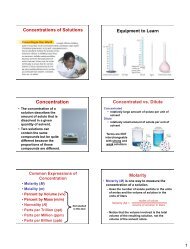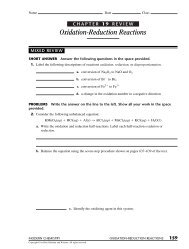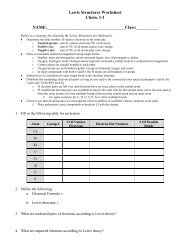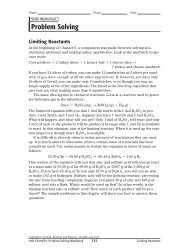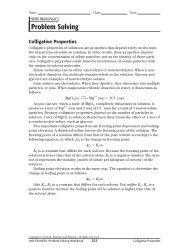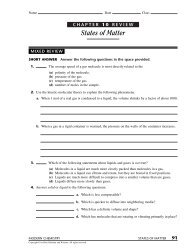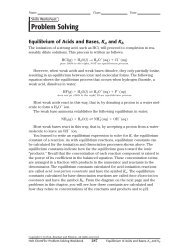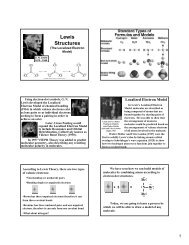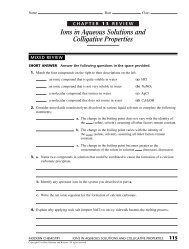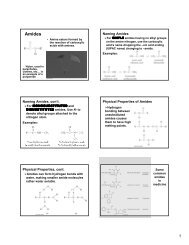Redox Equations
Redox Equations
Redox Equations
You also want an ePaper? Increase the reach of your titles
YUMPU automatically turns print PDFs into web optimized ePapers that Google loves.
Name Class DateSkills WorksheetProblem Solving<strong>Redox</strong> <strong>Equations</strong>The feature that distinguishes redox reactions from other types of reactions isthat elements change oxidation state by gaining or losing electrons. Compare theequations for the following two reactions:(1) KBr(aq) AgNO 3 (aq) → AgBr(s) KNO 3 (aq)(2) 2KBr(aq) Cl 2 (g) → 2KCl(aq) Br 2 (l)Equation 1 represents the combining of the salts potassium bromide solutionand a silver nitrate solution to form a precipitate of insoluble silver bromide,leaving potassium nitrate in solution. The only change that occurs is that ionstrade places, forming an insoluble compound. This reaction is a typical doubledisplacementreaction. It is driven by the removal of Ag and Br from solutionin the form of a precipitate.You will recognize that Equation 2 is a single-displacement reaction in whichchlorine atoms replace bromine atoms in the salt KBr. Although it is not complex,Equation 2 differs from Equation 1 in a fundamental way. In order for chlorine toreplace bromine, the uncharged atoms of elemental chlorine must change intochloride ions, each having a 1 charge. Also, bromide ions with a 1 chargemust change into uncharged bromine atoms. The K is a spectator ion thatdoesn’t participate in the process. In fact, it could be Na , Ca 2 , Fe 3 , H , or anyother stable cation.The loss of electrons by bromine is oxidation, and the gain of electrons bychlorine is reduction.Formation of the chloride ions and the bromine molecule involves the completetransfer of two electrons. The two chlorine atoms gain two electrons, andtwo bromide ions lose two electrons. Oxidation and reduction can involve thepartial transfer of electrons as well as the complete transfer seen in the precedingexample. The oxidation number of an atom is not synonymous with the charge onthat atom, so a change in oxidation number does not require a change in actualcharge. Take the example of the following half-reaction:H 2 C 2 O 4 (aq) → 2CO 2 (g) 2H (aq) 2e Carbon changes oxidation state from 3 to 4. Carbon is oxidized even though itis not ionized.The potassium bromide–chlorine reaction is simple, but many redox reactionsare not. In this worksheet, you will practice the art of balancing redox equationsand try your hand at more-complex ones.Copyright © by Holt, Rinehart and Winston. All rights reserved.Holt ChemFile: Problem-Solving Workbook 303 <strong>Redox</strong> <strong>Equations</strong>
Name Class DateProblem Solving continuedThere are seven simple steps to balancing redox equations. You will find thesesteps in the General Plan for Balancing <strong>Redox</strong> <strong>Equations</strong>.General Plan for Balancing <strong>Redox</strong> <strong>Equations</strong>1Write the unbalanced formula equation if it is not given. Listformulas for any ionic substances as their individual ions, andwrite a total ionic equation.2Assign oxidation numbers to each element. Then rewrite theequation, leaving out any ions or molecules whose elements donot change oxidation state during the reaction.3Write the half-reaction for reduction. You must decide whichelement of the ions and molecules left after item 2 is reduced.Once you have written the half-reaction, you must balance it forcharge and mass.4Write the half-reaction for oxidation. You must decide whichelement of the ions and molecules left after item 2 is oxidized.Once you have written the half-reaction, you must balance it forcharge and mass.5Adjust the coefficients of the two half-reactions so that the samenumber of electrons are gained in reduction as are lost inoxidation.6Add the two half-reactions together. Cancel out anything commonto both sides of the new equation. Note that the electronsshould always cancel out of the total equation.7Combine ions to form the compounds shown in the originalformula equation. Check to ensure that all other ions and atomsbalance.Copyright © by Holt, Rinehart and Winston. All rights reserved.Holt ChemFile: Problem-Solving Workbook 304 <strong>Redox</strong> <strong>Equations</strong>
Name Class DateProblem Solving continuedREACTIONS IN ACIDIC SOLUTIONSample Problem 1Write a balanced redox equation for the reaction of hydrochloric acidwith nitric acid to produce aqueous hypochlorous acid and nitrogenmonoxide.SolutionANALYZEWhat is given in the problem?What are you asked to find?the reactants and products of a redox reactionthe balanced redox reactionItemsDataReactants HCl, HNO 3ProductsSolution typeHClO, NOacidicOxidized species ?Reduced species ?Balanced equation ?PLANWhat steps are needed to balance the redox equation?1. Write the unbalanced formula equation followed by the ionic equation.2. Assign oxidation numbers to each element. Delete any ion or molecule inwhich there is no change in oxidation state.3. Write the half-reaction for reduction, and balance the mass and charge. H and H 2 O may be added to either side of the equation to balance mass.4. Repeat step 3 for the oxidation half-reaction.5. Adjust the coefficients so that the number of electrons lost equals the numberof electrons gained.6. Combine the half-reactions, and cancel anything common to both sides of theequation.7. Combine ions to change the equation back to its original form, and check thebalance of everything.COMPUTE1. Write the formula equation.HCl(aq) HNO 3 (aq) → HClO(aq) NO(g)Write the total ionic equation.H Cl H NO 3 → H ClO NOCopyright © by Holt, Rinehart and Winston. All rights reserved.Holt ChemFile: Problem-Solving Workbook 305 <strong>Redox</strong> <strong>Equations</strong>
Name Class DateProblem Solving continuedEVALUATEAre the units correct?NAIs the number of significant figures correct?NAIs the answer reasonable?Yes; the reaction has the reactants and products required and is balanced.PracticeBalance the following redox equations. Assume that all reactions take place in anacid environment where H and H 2 O are readily available.1. Fe SnCl 4 → FeCl 3 SnCl 2 ans: 2Fe 3SnCl 4 3 2FeCl 3 3SnCl 22. H 2 O 2 FeSO 4 H 2 SO 4 → Fe 2 (SO 4 ) 3 H 2 Oans: H 2 O 2 2FeSO 4 H 2 SO 4 3 Fe 2 (SO 4 ) 3 2H 2 O3. CuS HNO 3 → Cu(NO 3 ) 2 NO S H 2 O ans: 3CuS 8HNO 3 33Cu(NO 3 ) 2 2NO 3S 4H 2 O4. K 2 Cr 2 O 7 HI → CrI 3 KI I 2 H 2 O ans: K 2 Cr 2 O 7 14HI 32CrI 3 2KI 3I 2 7H 2 OCopyright © by Holt, Rinehart and Winston. All rights reserved.Holt ChemFile: Problem-Solving Workbook 307 <strong>Redox</strong> <strong>Equations</strong>
Name Class DateProblem Solving continuedREACTIONS IN BASIC SOLUTIONSample Problem 2Write a balanced equation for the reaction in a basic solution of NiO 2 andFe to produce Ni(OH) 2 and Fe(OH) 2 .SolutionANALYZEWhat is given in the problem?What are you asked to find?the reactants and products of a redox reactionthe balanced redox reactionItemsReactantsDataNiO 2 , FeProducts Ni(OH) 2 , Fe(OH) 2Solution typebasicOxidized species ?Reduced species ?Balanced equation ?PLANWhat steps are needed to balance the redox equation?1. Write the formula equation followed by the ionic equation.2. Assign oxidation numbers to each element. Delete any ion or molecule inwhich there is no change in oxidation state.3. Write the half-reaction for reduction, and balance the mass and charge. OH and H 2 O may be added to either side.4. Repeat step 3 for the oxidation half-reaction.5. Adjust the coefficients so that the number of electrons lost equals the numberof electrons gained.6. Combine the half-reactions, and cancel anything common to both sides of theequation.7. Combine ions to change the equation back to its original form, and check thebalance of everything.COMPUTE1. Write the formula equation.NiO 2 Fe → Ni(OH) 2 Fe(OH) 2Write the total ionic equation.NiO 2 Fe → Ni 2 2OH Fe 2 2OH Copyright © by Holt, Rinehart and Winston. All rights reserved.Holt ChemFile: Problem-Solving Workbook 308 <strong>Redox</strong> <strong>Equations</strong>
Name Class DateProblem Solving continued2. Assign oxidation numbers to each element.42 0 2 21 2 21Ni O2 Fe → Ni 2 2OH Fe 2 2OH Delete any ions or molecules in which there is no change in oxidation state.4Ni O2 Fe0 2 2→ Ni 2 Fe 23. Write the half-reaction for reduction.4 2Ni O2 → Ni 2Balance the mass by adding OH and H 2 O.4 2Ni O2 2H 2 O → Ni 2 4OH Balance the charge by adding electrons to the side with the higher positivecharge.4Ni O2 2H 2 O 2e 2→ Ni 2 4OH 4. Write the half-reaction for oxidation.Fe0 2→ Fe 2The mass is already balanced.Balance the charge by adding electrons to the side with the higher positivecharge.Fe0 2→ Fe 2 2e 5. The numbers of electrons lost and gained are already the same.6. Combine the half-reactions.4Ni O2 2H 2 O 2e 2→ Ni 2 4OH Fe0 2→ Fe 2 2e NiO 2 2H 2 O Fe → Ni 2 Fe 2 4OH 7. Combine ions to change the equation back to its original form. The four OH ions combine with the nickel and iron to make nickel(II) hydroxide andiron(II) hydroxide.NiO 2 2H 2 O Fe → Ni(OH) 2 Fe(OH) 2Check the balance.EVALUATEAre the units correct?NAIs the number of significant figures correct?NAIs the answer reasonable?Yes; the reaction has the reactants and products required and is balanced.Copyright © by Holt, Rinehart and Winston. All rights reserved.Holt ChemFile: Problem-Solving Workbook 309 <strong>Redox</strong> <strong>Equations</strong>
Name Class DateProblem Solving continuedPracticeBalance the following redox equations. Assume that all reactions take place in abasic environment where OH and H 2 O are readily available.1. CO 2 NH 2 OH → CO N 2 H 2 O ans: CO 2 2NH 2 OH 3 CO N 2 3H 2 O2. Bi(OH) 3 K 2 SnO 2 → Bi K 2 SnO 3 (Both of the potassium-tin-oxygen compoundsdissociate into potassium ions and tin-oxygen ions.)ans: 2Bi(OH) 3 3K 2 SnO 2 3 2Bi 3K 2 SnO 3 3H 2 OCopyright © by Holt, Rinehart and Winston. All rights reserved.Holt ChemFile: Problem-Solving Workbook 310 <strong>Redox</strong> <strong>Equations</strong>
Name Class DateProblem Solving continuedAdditional ProblemsBalance each of the following redox equations. Unless stated otherwise, assumethat the reaction occurs in acidic solution.1. Mg N 2 → Mg 3 N 22. SO 2 Br 2 H 2 O → HBr H 2 SO 43. H 2 S Cl 2 → S HCl4. PbO 2 HBr → PbBr 2 Br 2 H 2 O5. S HNO 3 → NO 2 H 2 SO 4 H 2 O6. NaIO 3 N 2 H 4 HCl → N 2 NaICl 2 H 2 O (N 2 H 4 is hydrazine; do notseparate it into ions.)7. MnO 2 H 2 O 2 HCl → MnCl 2 O 2 H 2 O8. AsH 3 NaClO 3 → H 3 AsO 4 NaCl (AsH 3 is arsine, the arsenic analogue ofammonia, NH 3 .)9. K 2 Cr 2 O 7 H 2 C 2 O 4 HCl → CrCl 3 CO 2 KCl H 2 O (H 2 C 2 O 4 is oxalicacid; it can be treated as 2H C 2 O 2 4 .)10. Hg(NO 3 ) 2 O3 HgO NO 2 O 2 (The reaction is not in solution.)11. HAuCl 4 N 2 H 4 → Au N 2 HCl (HAuCl 4 can be considered as H AuCl 4 .)12. Sb 2 (SO 4 ) 3 KMnO 4 H 2 O → H 3 SbO 4 K 2 SO 4 MnSO 4 H 2 SO 413. Mn(NO 3 ) 2 NaBiO 3 HNO 3 → Bi(NO 3 ) 2 HMnO 4 NaNO 3 H 2 O14. H 3 AsO 4 Zn HCl → AsH 3 ZnCl 2 H 2 O15. KClO 3 HCl → Cl 2 H 2 O KCl16. The same reactants as in Item 15 can combine in the following way whenmore KClO 3 is present. Balance the equation.KClO 3 HCl → Cl 2 ClO 2 H 2 O KCl17. MnCl 3 H 2 O → MnCl 2 MnO 2 HCl18. NaOH H 2 O Al → NaAl(OH) 4 H 2 in basic solution19. Br 2 Ca(OH) 2 → CaBr 2 Ca(BrO 3 ) 2 H 2 O in basic solution20. N 2 O NaClO NaOH → NaCl NaNO 2 H 2 O in basic solution21. Balance the following reaction, which can be used to prepare bromine in thelaboratory:HBr MnO 2 → MnBr 2 H 2 O Br 222. The following reaction occurs when gold is dissolved in aqua regia. Balancethe equation.Au HCl HNO 3 → HAuCl 4 NO H 2 OCopyright © by Holt, Rinehart and Winston. All rights reserved.Holt ChemFile: Problem-Solving Workbook 311 <strong>Redox</strong> <strong>Equations</strong>


